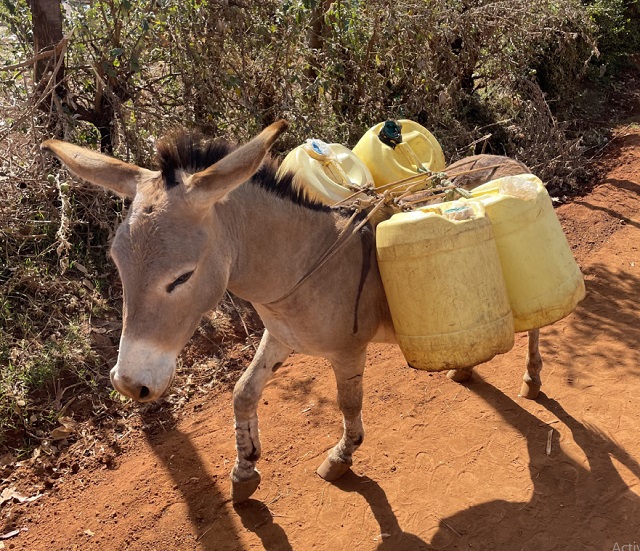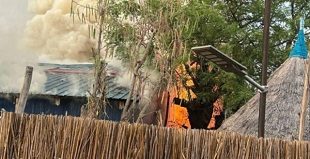
Research shows donkey skins are being sourced and shipped from more countries than earlier thought
Kampala, Uganda | RONALD MUSOKE | Organised criminals are exploiting online social media platforms such as Facebook, Twitter, Instagram and WeChat to facilitate the smuggling and trade in donkey skins, according to a new report published by The Donkey Sanctuary—a UK-based animal welfare non-profit organisation.
The report titled “The Global Trade in Donkey Skins: A Ticking Time Bomb,” estimates that over 4.8 million donkeys from around the world are trafficked and slaughtered for their skins every year. Of these, close to 42% are illegally trafficked to satisfy the ever growing demand for ejiao, a traditional Chinese remedy.
The continuous demand from the ejiao industry has had a significant impact on donkey populations and economic prospects to the families who rely on the animals for their livelihoods.
The report notes that majority of organised criminals operating online often offer donkey skins for sale, alongside other illegal wildlife products including rhino horns, pangolin scales, elephant ivory and tiger hides.
The Donkey Sanctuary’s report citing the findings of a research paper by an interdisciplinary team from Oxford University’s Saïd Business School and the Wildlife Conservation Research Unit (WildCRU), unearthed evidence of 382 individual traders on business-to-business (B2B) eCommerce sites offering donkey hides and almost 20% of those traders were also selling other wildlife products.
In some extreme cases, the traders were additionally trafficking narcotics, fake passports and human hair, providing further evidence of how deeply the donkey skin trade is embedded in organised crime.
With the creation of a data set of nearly 15,000 product offerings including wildlife, the scale of the problem is so extensive that The Donkey Sanctuary identified several traders openly admitting to the illegality of their merchandise, and even offering prospective buyers information on how they will avoid the skins being intercepted by the authorities during transit.
“There is no doubt that the global ejiao trade is having a devastating impact on the welfare of donkeys around the world, which suffer at every point from source to slaughter,” said Marianne Steele, the Acting CEO of The Donkey Sanctuary.
“This new research demonstrates just how vast the online donkey skin trade has become, and how entrenched it is with criminal activity and other illegal wildlife trafficking.”
“By cracking down on the sale of donkey skins on their platforms, eCommerce and social media sites will not only prevent considerable cruelty to donkeys, but also help eliminate the other criminal activity that is taking place alongside it and support thousands of families who rely on their donkeys to survive,” she said.
“Our work brings together concerns about wildlife conservation, animal welfare and the well-being of some of the world’s poorest communities, all around the unexpected focal point of donkeys,” added Dr Ewan Macdonald, a postdoctoral research fellow at Saïd Business School and co-author of the “Link between Wildlife Trade and the Global Donkey Skin Product Network.”
The research has, for the first time, shown a scientific link between the wider wildlife trade and donkey skin sales especially in China.
The Southeast Asian nation not only recognizes that smuggling of donkey skins takes place but that it is set to increase, according to the 2021 market analysis paper by the Donkey Branch of the China Animal Husbandry Association. This is because some enterprises that do not abide by the law are likely to increase their willingness to smuggle and participate in the illegal trade.
In many cases, however, the trade in donkey skins is itself illegal, since a growing number of countries have banned the export of donkey skins in an attempt to safeguard national donkey populations and the communities who depend on them.
Despite this, donkeys are being slaughtered, and their skins exported in direct defiance of national prohibitions, and recipient government administrations are complicit in this, a practice which undermines national efforts to protect donkey populations.
Chinese customs authorities oblige source country donkey slaughter and export facilities to register with them for the purposes of bio-security, veterinary and quarantine regulations.
However, these facilities are frequently located in countries where an export prohibition of skins, either directly (Nigeria, Benin, Ghana) or because countries have withdrawn licences from donkey slaughter houses (Kenya, Tanzania).
Global shipping
The links between the global donkey skin trade and wildlife trafficking extend beyond products being offered for sale alongside each other.
Seizure records maintained by customs authorities show that donkey skins are shipped alongside products from a wide range of wild animals, including those that are listed by the UN’s Convention on International Trade in Endangered Species of Wild Flora and Fauna (CITES).
Customs seizure reports and records, as well as news reports obtained by WildCRU show evidence of donkey skins being shipped with elephant tusks, pangolin scales, abalone, sea cucumber, shark fins, tiger skins and fish maw.
Many of these items are CITES Appendix I listed meaning that commercial trade is either entirely illegal or at least tightly controlled. Traders exporting donkey skins can simply designate their cargo under one of the internationally recognized Harmonized system or HS codes which is the standardized numerical method of classifying traded products.
Customs authorities globally use the HS system to identify products when assessing duties and taxes, and for gathering statistics but shippers are under no obligation to provide any more detailed description of the consignment.
A single HS code 410120 covers all equine and bovine-derived skins, and this vagueness is routinely exploited by exporters who provide either ambiguous descriptions or no description at all.
For example, analysis of 410120 exports from South Africa, which has a national slaughter quota of 12,000 donkeys for export of skins to China, found only nine consignment records, none with descriptions and all from 2017.
This practice is regularly seen in wildlife trafficking according to TRAFFIC, a leading NGO working globally on issues of trade in wild animals and plants in the context of both biodiversity conservation and sustainable development.
TRAFFIC notes: “Descriptions of commodities are vague or misleading.” Examples of vague descriptions for wildlife shipments include; “shell,” “horn,” and “rosewood” (there are many species of rosewood, some of which can be traded legally, and others prohibited from international trade). Up to 500 consignments of 410120 from known donkey skin source countries were examined.
While the lack of specificity of the 410120 code makes it impossible to know precisely what was in each of the consignments, the majority were either listed as donkey or equine skins or were shipped by known donkey skin exporters and received by known donkey skin importers.
The analysis has revealed that donkey skins may be being sourced and shipped from much more diverse range of countries than had previously realized. There is also no explicable reason for the huge variation in average values for the consignments going to China and those to Vietnam and Hong Kong.
Only 17 consignments of 410120, valued at US$ 2.7 million were recorded from Africa to China. Details of shippers are not listed and quantities of products are not recorded.
But, based on the documented data about the scale of the trade in Africa, these consignments only represent a fraction, less than 1% of the actual numbers of skins exported from Africa over the five year period.
Donkey populations declining
Trade in processed donkey skin, which is considered a “miracle cure” has been flourishing in recent years in China. And so has been the demand for donkeys.
Yet the breeding of donkeys cannot cope with the demand. Donkeys are said to have an average gestation period of 12-13 months and they usually give birth to one foal every 3-4 years. But that has not stopped Chinese ejiao dealers to source for and slaughter the donkeys at will.
When they were first approached by Chinese dealers, African countries saw it as another big trade opportunity. But the demand was simply too much.
Countries such as Zimbabwe, Burkina Faso, Mali and Ghana opposed and imposed licence freezes.Others such as South Sudan, Uganda, Senegal, Botswana, Sudan and Niger banned the export or trade of the donkey skins to China.
But others saw an economic opportunity in overseas trading partners—and approved the construction of donkey slaughterhouses through Chinese investments. East Africa soon turned into a centre of the donkey skin trade within a few years, escalating the illegal donkey trade.
Since 2016, Welttierschutzgesellschaft e.V, a German animal welfare non-profit has observed an increasing number of donkey thefts, first in Tanzania and also in Kenya especially in the remote villages where people live with three to four donkeys for self-sufficiency.
In Uganda, poor farmers in the north-eastern Elgon sub-region which neighbours Kenya recently told local broadcaster, NTV, how they have been losing donkeys to thieves.
They attribute the theft to increased prices of donkeys, which now costs Shs 1.2 million per head, a price which is almost six times the cost the animal used to be bought. According to farmers, most of the stolen donkeys are sold to buyers in neighbouring Kenya who slaughter and harvest their skins before they are shipped to China.
The Uganda Bureau of Statistics (UBOS) is expected to conduct a national livestock census this year. But according to the last census conducted in 2008, there were about 150,000 donkeys in Uganda; 90% of which were found in the north-eastern semi-arid region of Karamoja.
But, apparently, their numbers have since dwindled by more than half. According to a recent mini-survey done with the help of district veterinary officers around Uganda, there are just about 50,000 donkeys left in Uganda.
Going forward, The Donkey Sanctuary is calling on all eCommerce and social media sites to immediately ban the sale of donkey skins and remove all existing listings from their platforms.
“The inhumane and unregulated donkey skin trade is among the biggest global threats to donkeys today. The suffering donkeys experience at the hands of this trade cannot be understated,” said Steele, the Acting CEO of The Donkey Sanctuary.
“Beyond this, every donkey stolen and slaughtered by traffickers leaves behind a family that relies on it to support their livelihood; often, it is the most vulnerable in these communities who suffer most.”
It is estimated that up to ten million communities in the developing world rely on working donkeys, and where they are stolen, women and girls pick up the ‘donkey work’ left behind, denying many girls the opportunity to continue with their education.
****
 The Independent Uganda: You get the Truth we Pay the Price
The Independent Uganda: You get the Truth we Pay the Price



